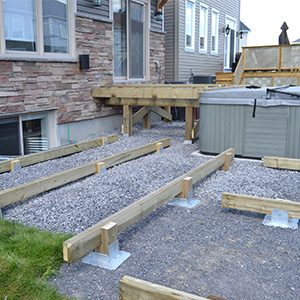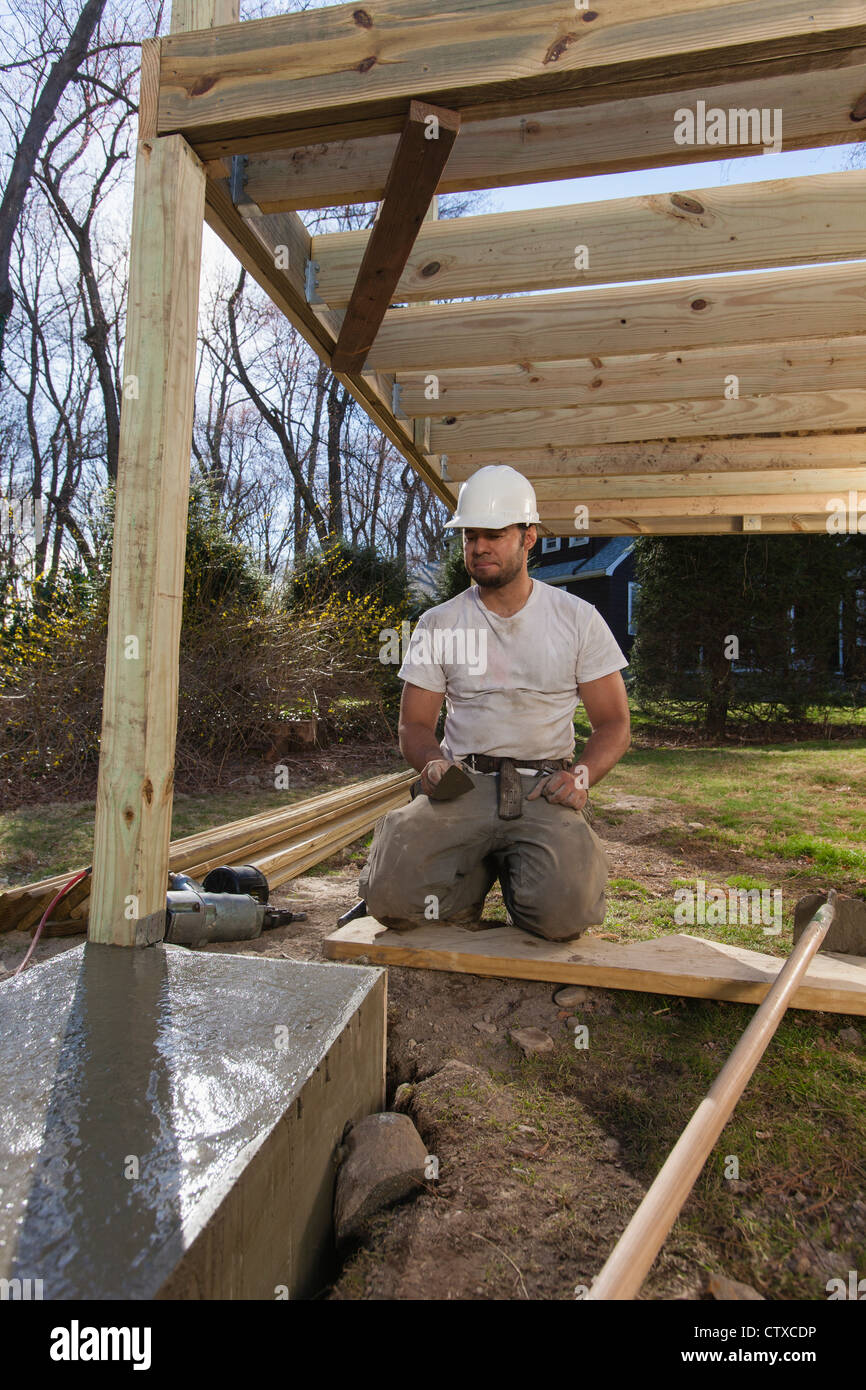Deck Footings Demystified: Your Plan for a Safe, Lasting Outdoor Place
Wiki Article
Make Certain Stability and Durability With Correctly Set Up Deck Grounds
Deck grounds might not be the most extravagant element of deck building, yet they play an important function in making certain security and longevity. In this conversation, we will discover the relevance of proper deck footings, factors to think about during installation, different types of grounds readily available, detailed setup overview, and upkeep tips for ensuring long-lasting footings.
Relevance of Proper Deck Grounds
Why are effectively installed deck footings crucial for the security and durability of your deck? The answer lies in the basic function that deck grounds play in supporting the weight of the whole structure. Deck footings are the foundation on which the deck relaxes, moving the lots from the deck to the ground. When grounds are not properly installed, it can bring about an array of concerns that compromise the security and durability of the deck.To start with, effectively mounted deck grounds disperse the weight of the deck evenly, avoiding any kind of uneven settling or sinking. This is particularly crucial in locations with unstable dirt, as it helps to alleviate the threat of the deck falling down or changing. In addition, well-installed footings guarantee that the deck continues to be degree, stopping any type of architectural damages that can occur when a deck ends up being uneven.
Second of all, properly set up grounds provide a strong support for the deck, avoiding too much motion and sway. This helps to maintain the structural integrity of the deck, lowering the risk of crashes or injuries. It also reduces the wear and tear on the deck, allowing it to stand up to the elements and routine usage for a longer time period.
Aspects to Think About for Deck Footing Installation
When mounting deck grounds, there are numerous vital elements to consider for appropriate installment. These elements can greatly affect the security and durability of your deck. You require to determine the kind of dirt on which the deck will be developed. Various soil kinds have different load-bearing capabilities, so it is essential to perform a soil test to ensure the grounds can support the weight of the deck and its owners. Furthermore, the area and design of the deck should be very carefully planned to stay clear of any type of barriers such as trees, utility lines, or underground pipes. It is likewise essential to think about the local environment and weather, as these can affect the resilience of the footings. Areas with a high water table may require additional steps to protect against water damage. The size and product of the footings ought to be selected based on the size and weight of the deck, as well as the local structure codes and laws. By considering these variables, you can make certain the correct installment of deck grounds and take pleasure in a steady and lasting deck.Kinds of Deck Footings to Pick From
There are several different kinds of deck footings available for you to choose from. Each kind has its very own benefits and downsides, so it's vital to consider your particular needs and the problems of your deck before making a decision.One common sort of deck footing is the concrete footing. This involves digging openings in the ground and putting concrete into them to produce a solid structure. Concrete grounds are sturdy and provide outstanding stability, making them suitable for decks in locations with tough dirt conditions or high wind tons.
One more option is the helical pier footing, which includes a steel shaft with helical plates that are screwed into the ground. These footings are fast to mount and can be utilized in numerous dirt types, including sandy or clay soils. They are also flexible, permitting for very easy progressing of the deck.
Sonotube grounds are another popular choice. These grounds are developed by positioning a cardboard tube in an opening and filling it with concrete. Sonotube footings are relatively very easy to install and provide appropriate stability for smaller sized decks or in locations with less requiring soil conditions.

When picking the kind of deck footing, it's important to take into consideration variables such as dirt problems, deck dimension and weight, regional structure codes, and individual choices. By selecting the ideal ground kind, you can make sure the security and longevity of your deck.
Step-by-Step Guide for Setting Up Deck Footings

Figure out the place: Begin by noting the exact placement of each ground making use of stakes and string (Deck Footings). Consider any type of regional building ordinance or guidelines regarding problem ranges
Dig the holes: Utilize a blog post opening miner or an auger to dig the openings for the grounds. Generally, a depth of at least 36 inches is suggested for stability.
Level the holes: Make sure that the bases of the openings are degree (Deck Footings). This can be achieved by utilizing a level or a straight board throughout the top of the openings
Include crushed rock: Area a layer of crushed rock at the bottom of each opening to improve drain and stop the ground from penetrating the dirt over time.
Insert the footing types: Put the footing forms right into the holes, ensuring they are centered and degree. Usage risks to safeguard them in place.
Mix and pour concrete: Comply with the directions on the concrete mix bag to prepare the concrete. Put the concrete right into the ground kinds, loading them entirely.
Smooth the surface area: Utilize a trowel to smooth the surface of the concrete and eliminate any air pockets. Enable the concrete to treat according to the maker's directions.
Maintenance Tips for Lasting Deck Footings
Proper maintenance is vital for making certain the long life and security of deck grounds. By regularly inspecting and keeping your deck grounds, you can stop damage and potential safety and security threats. One important facet of upkeep is to frequently look for any kind of indicators of damage, such as splits or motion in the footings. If you see any kind of problems, it is very important to resolve them without delay to stay clear of more damages.Regular cleansing is also vital for maintaining deck footings. Debris, dust, and vegetation can build up around the grounds, which can bring about moisture buildup and degeneration. Cleaning the grounds regularly, utilizing a brush or a pressure washer, can aid avoid these problems and extend the life expectancy of your deck.
Along with cleaning, it is very important to keep the area around the grounds free from any kind of blockages. Avoid piling things versus the footings or enabling plants to expand also near to them. These blockages can trap wetness and create the footings to deteriorate in time.
Lastly, normal resealing of the footings is advised to secure them from moisture and other ecological aspects. Using a water resistant sealant can help prevent water damages and extend the lifespan of the footings.
Conclusion
Finally, proper their explanation installment of deck reference grounds is critical for ensuring security and long life of your deck. Aspects such as soil type, load ability, and neighborhood building regulations need to be considered when picking the appropriate sort of deck grounds. Complying with a step-by-step overview for installment and routine maintenance will certainly assist to make sure the footings remain long-lasting and sturdy.In this conversation, we will certainly explore the importance of proper deck grounds, variables to take into consideration throughout setup, different types of grounds available, detailed installment overview, and upkeep suggestions for guaranteeing durable grounds. Deck footings are the structure on which the deck relaxes, transferring the lots from the deck to the ground.One usual type of deck footing is the concrete footing. Put the footing forms: Put the footing forms into the openings, ensuring they are centered and degree.In final thought, proper installation of deck grounds is vital for guaranteeing stability and long life of your deck.
Report this wiki page